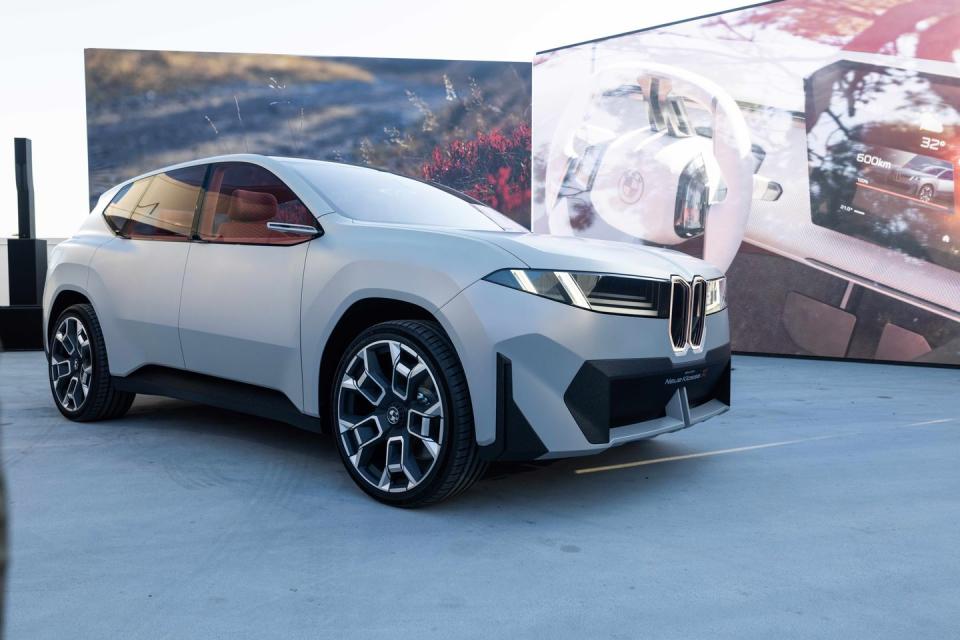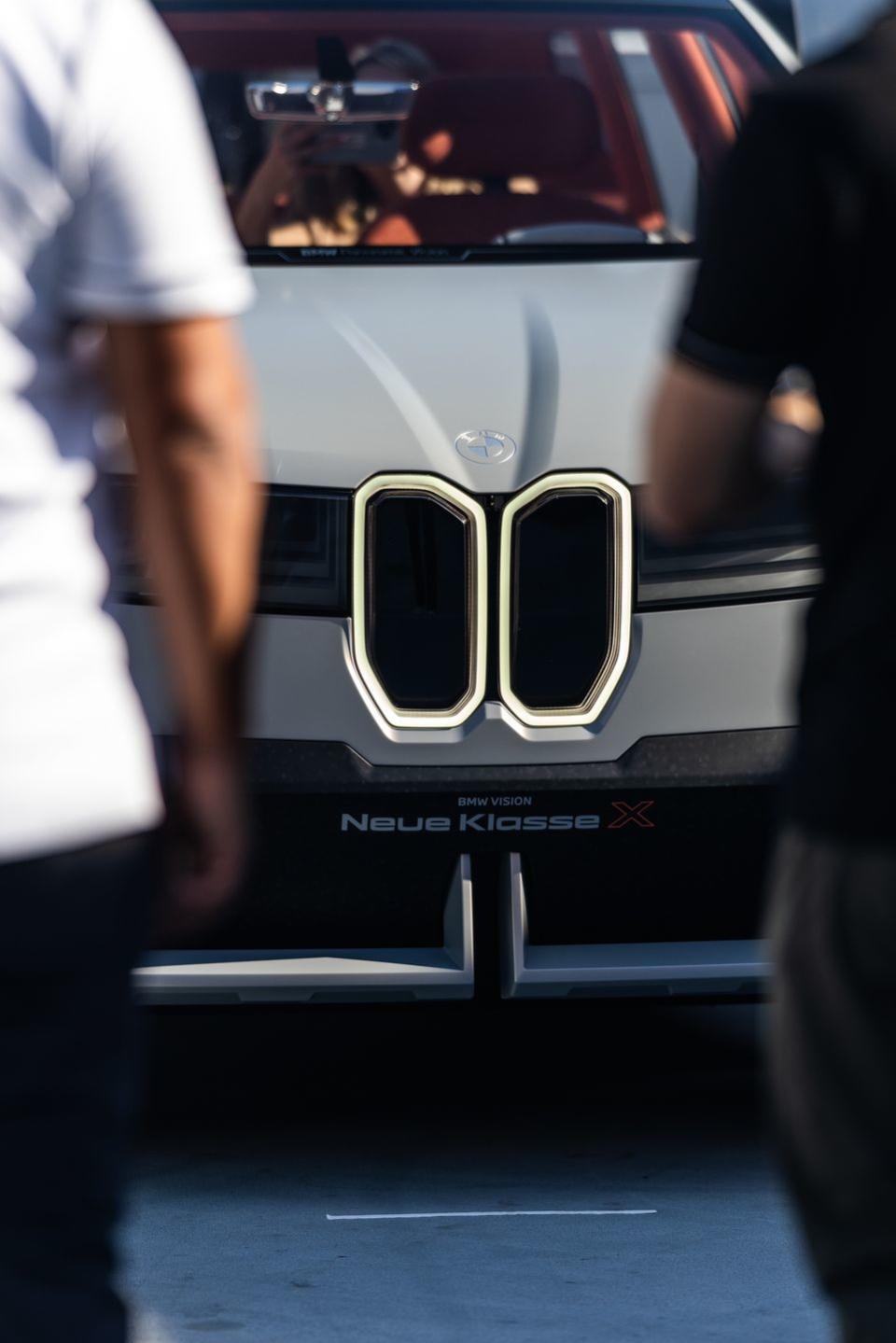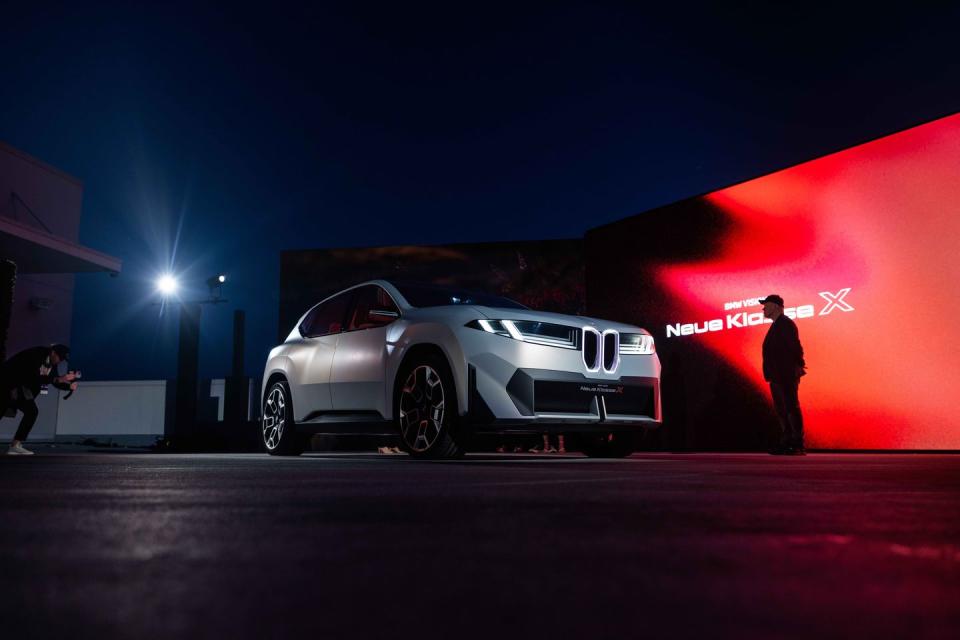The Neue Klasse X previews the design language for future BMW SUVs.
The architecture is powered by a new high-performance computing platform.
Generative AI helped to inspire—and was inspired by—Neue Klasse X details.
In Steven Spielberg's movie AI: Artificial intelligence, a highly advanced robotic boy longs to become "real" so that he can regain the love of his human mother. Which begs the debate: are we made human because of our brains? Or is a brain just a highly advanced computer capable of emotion? With the Neue Klasse X project, BMW believes it can be both. The concept was presented at an event at the Petersen Automotive Museum in Los Angeles earlier this month.
One of the challenges of meeting the right partner is in finding that perfect mix of looks, brains, and personality. Choosing the ideal car is no different. For the majority of the automobile's existence, internal-combustion engines have provided the lion's share of creating a distinct personality. But an EV motor's inherent lack of sound creates a silent void in this equation. Sure, one could replicate the mighty blat of a V-8 à la Dodge's upcoming EV Charger, but the design team behind the Neue Klasse X concept took a different approach.
"We as designers had to relearn how to design," remarked Julia de Bono, CEO of BMW's DesignworksUSA. When developing the language for the Neue Klasse X, she and her team took inspiration from a human's five senses. The goal was to personify the design in a way that aligned closely with these senses in order to create a stronger bond between a vehicle and its occupants. De Bono says that stepping inside the Neue Klasse X should feel like "a hug from a car. A digital hug." She also described the pairing as "phygital," which proves that man and machine should probably go on a few more dates before committing to defining the relationship in words.
As a stand-alone design, however, the Neue Klasse X displays a refreshing (some might say welcome) return to form for the automaker. Much as the 1961 Lincoln Continental reset the bar for American automotive design after a decade defined by tailfins and chrome, the Neue Klasse X ditches gaudy extroversion for tasteful restraint. According to de Bono, the philosophy behind the design was the Italian term sprezzatura, loosely translated into English as "a sense of ease." It's a humbling concept from an automaker increasingly known for questionable styling choices over the past 20 years.
But the phrase rings true. Seen in person, the Neue Klasse X is a beautifully cohesive package. The exterior contains a litany of fascinating details that work in harmony rather than competing for attention. The vertical twin-kidney grille finally looks at home on a modern BMW. The front splitter evokes the muscular form of an Olympian straddling the rings, while the rear diffuser seems to float on its own just beneath the bumper. Overall, this is a shape that will look just as good 20 years from now.
Inside, recycled plastic and plant-based materials embrace sustainability, but it's the co*ckpit tech that takes center stage. In lieu of a traditional instrument panel, there's a panoramic screen which stretches the width of the dashboard at the base of the windshield. Its content can be changed on the fly by using the center-mounted touchscreen to drag and drop icons into respective positions. The touchscreen is also home to a sound generator wheel, enabling users to personalize the "engine sound" along four quadrants: Calm, Free, Agile, and Expressive. The system, anointed HYPERSONX, allows for millions of different variations, with a mashup name that's slightly more successful than phygital.
"Braincraft"
All of this technology is powered by a "super brain," a term used to describe BMW's new generation of high-performance computing. Future BMWs will feature four super brains working in concert to create a seamless communication across all aspects of the car. BMW is mum on whether one of the brains will aspire to be a real human, but it might make a digital hug that much more convincing.
Increasing amounts of artificial gray matter are being employed in the design process. Hussein Al-Atar, director of automotive design for Designworks LA, sees AI as a way to accelerate the process from idea to conceptualization. The initiative, appropriately titled "Braincraft," employs a variety of generative AI tools in this mission.
Al-Attar says that the human-machine collaboration helps to spur originality, especially during initial ideation. "Designers look for inspiration everywhere," and that using AI helps to "kick=start the creativity at a very early stage." At this step in the process, the focus is less about sheetmetal and more about materials, colors, and shapes.
Mood Board
From there, Al-Attar and his team take the AI images and put them together to create a mood film. The resultant video is indeed awash of the kind of imagery one might expect at this stage of technology, like an iPhone commercial was projected through a kaleidoscope and then dragged through a field of stalactites. The undulating shapes manage to appear simultaneously jagged and fluffy, as if the designers fed the AI mushrooms instead of prompts.
But Al-Attar says that this is the entire point. "The more abstract the images are, the more interesting the result. If it's an abstract shape to start, the AI-generated hallucinations, creating trippy, psychedelic inspirations." It's an ideal match for the goal of achieving all five senses for the Neue Klasse project.
Al-Attar says the main challenge of using AI tools is the running the risk of recycling old motifs. Generative AI relies on its database of existing elements to create imagery. If the designers had simply fed the system with their own work, the end result would be a feedback loop, and not truly pushing the needle.
The final shape of the Neue Klasse X concept has also provided an opportunity to apply the inspiration process in reverse. Al-Attar asked his team, "How can we use AI to create world-building when the product is already finished?" Photos of the Neue Klasse X were fed into the AI brains along with marketing-focused prompts, creating richly layered, hyperkinetic posters that would look right at home on a billboard.
When the production version of the Neue Klasse X debuts in 2025 as the next-generation iX3, we'll be able to experience all of this brainpower for ourselves. With six more Neue Klasse–inspired vehicles on the way, BMW is bullish on delivering that elusive mix of looks, brains, and personality. And, occasionally, a hug.
You Might Also Like



